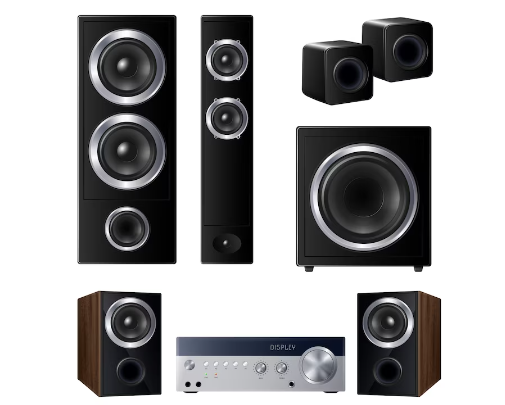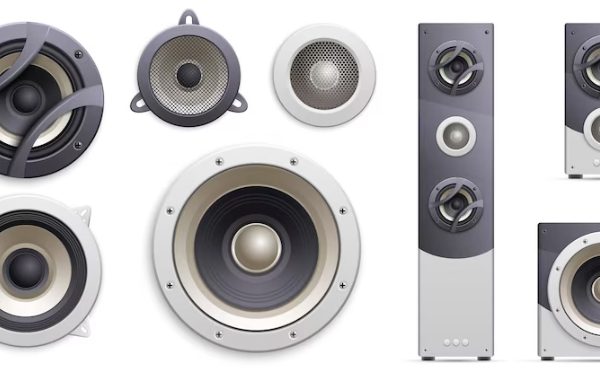Step-by-Step Guidelines for Choosing the Right Home Theater Speakers
When it comes to creating an exceptional audiovisual experience in your home, selecting the right home theater speakers plays a pivotal role. While a high-definition display can bring visuals to life, it is the speakers that truly immerse you in the world of sound. They have the power to transport you into the heart of a movie, make you feel the intensity of a concert, or amplify the thrill of a gaming session.
Home theater speakers have the ability to elevate your entertainment experience by delivering rich, detailed sound that complements the visuals on the screen. They add depth, realism, and dimension to the audio, allowing you to hear every whisper, explosion, and musical note with clarity and precision. Whether you’re enjoying a movie night with family, hosting a gaming tournament with friends, or simply indulging in your favorite music, the right speakers can transform your living space into a personal entertainment haven.
In this blog, we will guide you through all the steps required to choose the right theater speakers for your home entertainment for your home and office. Follow this guideline to make decisions about your Home Theater Speakers.
Assess Your Space for Speaker
It’s essential to assess your space thoroughly. This step will help you understand the unique characteristics and limitations of your room, enabling you to make informed decisions regarding speaker placement and configuration. Here’s why this assessment is crucial:

Room Size and Layout:
Start by measuring the dimensions of your room. Larger rooms may require more powerful speakers to fill the space with immersive sound, while smaller rooms may benefit from smaller, compact speakers. Additionally, take note of any architectural features or room layout elements, such as windows, doors, or columns, which may affect speaker placement.
Acoustic Properties:
Assess the acoustic properties of your room, including its sound reflections, reverberations, and potential sound traps. Hard surfaces like bare walls, wooden floors, or large windows can create sound reflections, while soft surfaces like carpeting or curtains can absorb sound. Understanding these characteristics will help you choose speakers that can compensate for any acoustic challenges and optimize audio performance.
Speaker Placement:
Consider the available space for speaker placement and how it aligns with recommended configurations. For instance, front speakers (left, center, and right) should ideally be positioned at ear level and equidistant from the primary listening area. Surround speakers (side and rear) should be strategically placed to create an enveloping sound field. Evaluating your room’s layout will help determine the feasibility and optimal placement options for your speakers.
Determine Speaker Types and Placement

Once you have assessed your room, it’s time to decide on the types of speakers you will need and their optimal placement. This step is crucial for achieving a balanced and immersive audio experience. Here’s a breakdown of common speaker types and their placement considerations:
Front Speakers:
Left, Center, and Right Speakers: These speakers are responsible for delivering the primary audio content, including dialogue, music, and sound effects. The center speaker, placed above or below the display, enhances dialogue clarity. The left and right speakers create a wide soundstage for stereo effects.
Surround Speakers:
Side Surround Speakers: Positioned on the sides of the listening area, these speakers contribute to the enveloping sound and immerse you in the audio experience.
Rear Surround Speakers: Placed behind the listening area, these speakers enhance the sense of depth and provide a more immersive sound field.
Subwoofer:
The subwoofer specializes in reproducing low-frequency sounds, such as deep bass and rumbling effects. It adds depth and impact to your audio experience. The placement of the subwoofer is generally more flexible and can be experimented with to achieve an optimal bass response.
Height Speakers:
Height Speakers: These speakers are positioned above the front left and right speakers, typically at ear level when seated. They create a vertical sound dimension, enhancing the sense of height and spaciousness of incompatible audio formats like Dolby Atmos or DTS: X.
Establish a Budget Range for Choosing the Right Home Theater Speakers
Setting a budget range is crucial for choosing home theater speakers. It allows you to establish your financial limits and concentrate on options that offer the most value within that range. By having a budget, you can make well-informed decisions and ensure that you invest in speakers that align with your requirements without exceeding your financial capacity.
Ensure Speaker System Compatibility
Ensuring the compatibility of your chosen speakers with your audio/video receiver or amplifier is a critical step in building your home theater system. Compatibility ensures that the speakers and the audio equipment work together seamlessly, delivering optimal performance. Here’s why it’s important and what factors to consider:
When it comes to compatibility, the first aspect to consider is speaker impedance. Impedance refers to the resistance that a speaker presents to the audio signal. It is measured in ohms and should match the output impedance of your audio equipment. Mismatched impedance can result in inefficient power transfer and compromised sound quality. Therefore, it is crucial to check the recommended impedance range of your speakers and ensure that it matches or is within the acceptable range of your receiver or amplifier
Seek Professional Advice for Home Theater Speaker
When faced with the overwhelming task of choosing home theater speakers and feeling uncertain about the options available, seeking professional advice can be highly beneficial. Home theater specialists and audio professionals have extensive knowledge and expertise in the field, making them valuable resources for guidance and assistance. By consulting with Home Tech Geeks, you can receive personalized recommendations tailored to your specific needs, preferences, and budget.
We will take into account various factors such as your room size, acoustics, seating arrangement, and desired audio experience. Based on this information, we can recommend speaker options that are best suited for your space and will deliver optimal sound quality. Our experience with different speaker brands, models, and configurations allows them to provide informed advice that aligns with your requirements.
Make the Final Decision to choose Speaker
Summarize your requirements, preferences, and research findings. Prioritize the features and performance factors that matter most to you. Consider the pros and cons of different speaker options, and weigh them against your budget and overall goals. Finally, select the home theater speaker system that best fits your space and fulfills your audio expectations.
By following these step-by-step guidelines, you’ll be well-equipped to choose the right home theater speaker that enhances your audiovisual experience and create a truly immersive cinematic environment in your own home.

